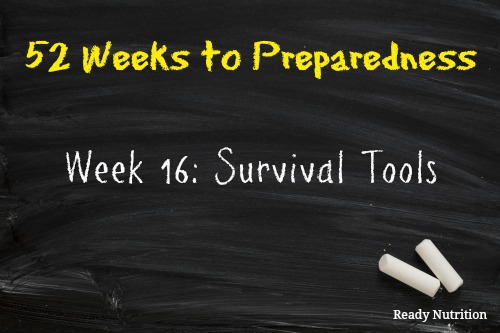
Preparedness requires the ability to fall back on a foundation of tools and supplies you can count on for survival. Our ancient ancestors depended on tools for survival, and we are no different. Having the right survival tools on hand for when unexpected emergencies occur can help assist you in getting your basic needs met, catch food, communicate with emergency officials, and find your way in the dark.
Good, quality tools are a sound investment that can last a lifetime if properly cared for. The ten tools listed below are the most important survival tools that should be in your 72-hour bags or survival bags. Practice using these tools regularly so that you know their capability and their strength.
The Top 10 Survival Tools For Your Survival Bags
- Water Treatment: We simply cannot live without water. The more energy you consume, the more water your body will need. Having a means to purify water in a survival situation will help keep you hydrated, your brain functioning properly and your focus on survival. In addition, if you sustain an injury, water can be poured over the wound for cleaning.
- Compass and Map: Knowing which direction you are headed and where you need to be are essential. Keep maps of your surrounding area at home (in case you have to evacuate by foot), in your car and in your survival bags.
- Fire Starter, flint bars, matches or lighter: Having a way to produce fire can help you cook food and keep warm and prevent hypothermia.
- First Aid Kit: You do not want to be caught in a survival situation without a first aid kit. This kit assists in injury treatment and helps prevent infections from perpetuating.
- Mirror: Used for signaling, checking face for wounds, looking at your back for wounds/ticks, and can be used to start fire.
- Rope: This can be used for making snares or assisting in making other traps lashing branches together to build a shelter, assisting in first aid (splints, tourniquets, slings), or to make survival tools such as spears.
- Survival Blanket or Bivvy: A bivvy or survival blanket can be used as an emergency shelter, sleeping bag or can be an extra layer added to your existing sleeping bag if you are expecting a cold night.
- Multi-tool: Used for notching or more complex wood working skills, opening cans, altering equipment, medical uses, if snare wire is around wire cutters can cut it.
- Lighting: Lanterns, light sticks, flashlights, and head lamps can help you find your way if in the dark. LEDs, solar and hand crank will get you the most for your money.
- Survival Knife: Survival knives should be made of good quality steel. Invest in one you can rely on. Make sure it is well made, is strong enough for rough field use, and is the best you can afford.
The bottom line is, your preparedness tools are your life line. The tools you choose should ones that you can depend on to assist in meeting your basic survival needs. Without them, you could be ill-equipped in a survival situation.
Preps To Buy:
- Candles or hurricane lamps
- Matches (regular and water-proof)
- Batteries (an assortment of sizes)
- Collapsible shovel or trowel
- Water treatment (purification tablets, chlorine granuals, water filtration system)
- Compass and map
- Fire starter
- First aid kit
- Mirror
- Duct tape
- Rope
- Signal flare or flashing beacon
- Survival blanket or Bivvy
- Multi-tool
- Lighting (lantern, light sticks, flashlights, head lamps)
- Survival knife
Action Items:
1. Prepare a survival kit or 72-hour bag with your survival tools included. Have this ready in case you have to make a quick evacuation.
2. Create a personal support network of neighbors and friends who can help you and your family if you are separated or unable to get home.
3. Give copies of the following lists to your network: emergency information list, contact information for various times of day.
4. Learn about sheltering-in-place and what items you may need to do so. Make a plan with your family and choose the area of your home where you will go.
This article was originally published at Ready Nutrition™ on August 19th, 2011







Looking forward to seeing your newsletter!
One thing I saw on TV survival show, tie a rope around a flash-light and swing it around if you are trying to be found, the light going around is more effective than a small beam.